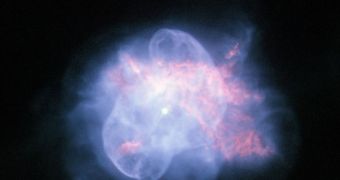Scientists operating the NASA Hubble Space Telescope managed to capture a new image of a dying star, which was observed as it was shedding atmospheric layers, and producing an asymmetric nebula.
The recently-observed body is located some 6,500 light-years away, which is relatively nearby by cosmic standards. It lies in the direction of the constellation Hercules, Space reports.
The planetary nebula is called HGC 6210, and experts say that it is currently in the final stages of its life, when it is ejecting its extra atmospheric layers, after exhausting its hydrogen fuel.
At the very core of the observed body is a rather small star, that is less massive than our Sun. The central structure was imaged in impressive detail, experts say.
This allowed astronomers to notice that the central star was entirely surrounded by a bluish bubble, which in turn revealed the presence of a delicate filamentary structure.
An asymmetric, reddish gas formation is mixed in with the main glowing bubble, the investigator says, and structures such as holes, filaments and pillars can be made out clearly within this second structure.
The observations were made with the Wide Field Planetary Camera 2, before May 2009. This is when Atlantis astronauts flee an 11-day repair mission to the Hubble.
As the telescope was docked to the space shuttle, the astronauts replaced video cameras and gyroscopes, in addition to the observatory's thermal shielding. This allowed the Hubble to become more sensitive than ever.
The NGC 6210 planetary nebula was not recently discovered. It was first seen by the German astronomer Friedrich Georg Wilhelm Struve back in1825, and since then astronomers have been conducting regular surveys of it.
Oddly enough, planetary nebulae have very little to do with planets. The term in fact refers to the shells and layers of outer gas that a dying star is releasing prior to suffering alterations to its core.
When a star dies, its core can either fizzle out as a white dwarf – which is what happens to stars the size of the Sun or smaller – or can turn into a neutron star or a black hole, if they go out in supernova explosions.
It is currently believed that the Sun will experience a fate similar to that of NGC 6210 in about 5 billion years. Our star is now halfway through its burning cycle, Space reports.

 14 DAY TRIAL //
14 DAY TRIAL //